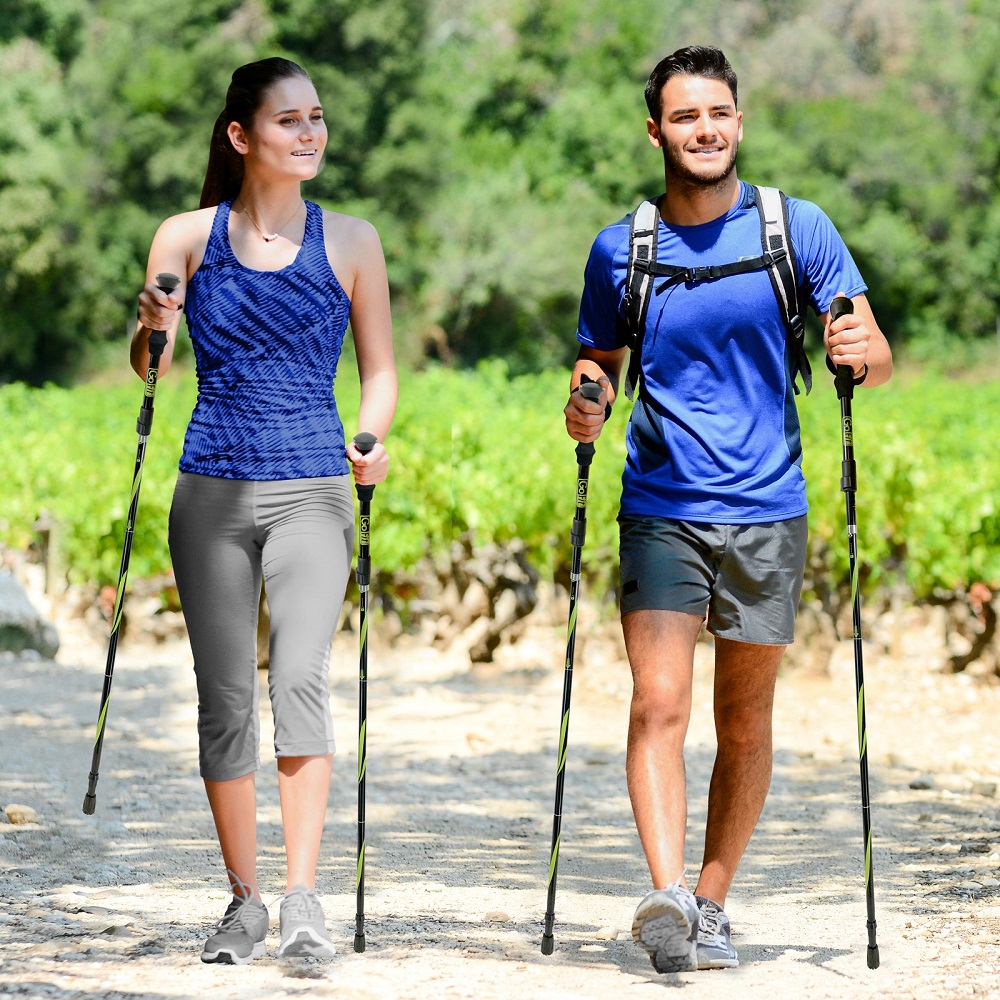What Are Hiking Sticks?
Hiking sticks, also known as trekking poles, are tools for outdoor walking activities. They provide support, balance, and stability on uneven terrain. These sticks can reduce strain on legs during uphill and downhill hiking. Essential features make them adaptable to various terrains and weather conditions.
Benefits of Using Hiking Sticks
Hiking sticks offer several advantages to improve your hiking experience:
- Enhanced Stability: Reduce the risk of falling on rocky or slippery trails.
- Reduced Stress on Joints: Help alleviate pressure on knees during descents.
- Improved Posture: Encourage upright walking, reducing back strain.
- Increased Endurance: Distribute effort between arms and legs to preserve energy.
- Support for Heavy Loads: Provide balance when carrying backpacks.
Using hiking sticks makes tough trails safer and significantly more comfortable for hikers.
Types of Hiking Sticks Available
Hiking sticks come in various designs tailored to different needs:
- Adjustable Hiking Sticks: Ideal for varied terrain due to customizable length.
- Fixed-Length Sticks: Known for durability and reliability.
- Collapsible Sticks: Portable and easy to store, great for travelers.
- Shock-Absorbing Sticks: Minimize impact on joints, recommended for longer treks.
- Ultra-Lightweight Sticks: Best for speed hiking or minimalists.
Each type offers unique features suited to specific hiking preferences and environments. Selecting the right one depends on your comfort, terrain, and hiking goals.
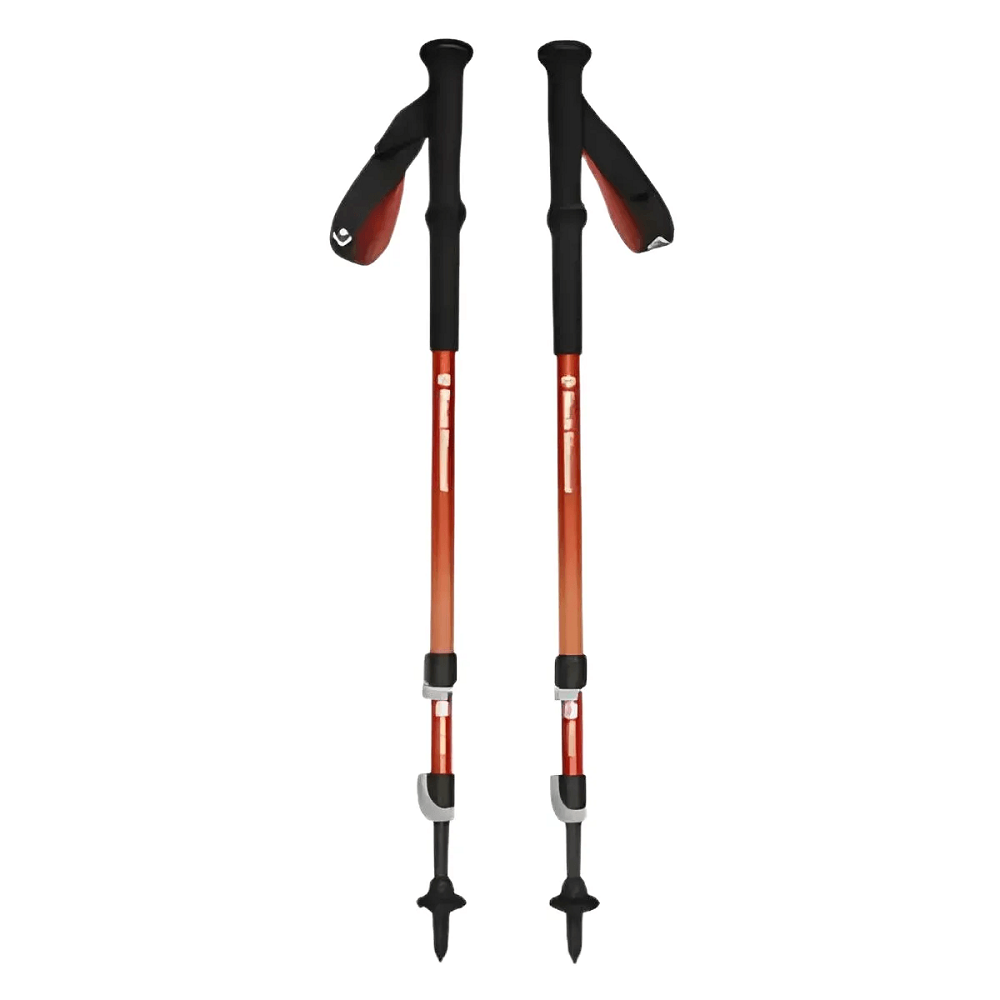
Key Factors to Consider When Choosing Hiking Stick
When choosing hiking sticks, several factors play a crucial role in ensuring an enjoyable experience. From durability to comfort, these elements determine performance and usability. Below are key aspects to focus on.
Material and Strength
The material determines the durability and weight of hiking sticks. Common materials include:
- Aluminum: Lightweight, strong, and affordable for general hiking.
- Carbon Fiber: Ultralight and sturdy, ideal for long treks but often pricier.
- Combination Materials: Provide a balance between weight and resilience.
Choose a material based on your hiking terrain and preferences. Strong materials excel on rugged trails.
Adjustable vs. Fixed Length Sticks
Hiking sticks are available in adjustable or fixed lengths:
- Adjustable Sticks: Let you change the length for different terrains.
- Fixed-Length Sticks: Offer consistent length and are often more durable.
If hiking on varied terrains, adjustable sticks provide versatility. Fixed-length sticks suit straightforward trails.
Weight and Portability
Lightweight hiking sticks reduce fatigue over long distances. Ultra-light options improve speed and convenience, especially for travelers. However, ensure they’re both portable and strong, as very lightweight options may compromise durability.
Grip Type and Comfort
Comfortable grips enhance your hiking experience significantly. Common grip materials include:
- Foam: Soft and absorbs sweat effectively.
- Rubber: Durable and best for wet conditions.
- Cork: Shapes to your hand for ultimate comfort.
Choose grips based on your hand size and preferred texture. Comfort is vital, especially on extended hikes.
By keeping these factors in mind, you can select hiking sticks tailored to your needs and terrain.
How to Choose Hiking Stick Based on Terrain
Different terrains require hiking sticks with specific features to enhance performance and safety. Selecting the right hiking sticks based on terrain ensures better stability, comfort, and efficiency on your journey.
Sticks for Flat Trails
For flat trails, lightweight and simple hiking sticks are ideal. Features to consider include:
- Fixed-Length Sticks: These provide consistent support on even terrain.
- Ultra-Lightweight Options: Minimize fatigue during long-distance flat walks.
- Rubber Tips: Offer superior grip on paved or dirt trails.
Flat trail hikes emphasize comfort, so prioritize ergonomic handles. Foam or cork grips improve hand comfort on these long treks.
Sticks for Mountainous and Steep Terrain
Mountainous terrains demand sturdy and versatile sticks. Key features include:
- Adjustable or Telescopic Sticks: Adapt the length for uphill or downhill movements.
- Shock Absorbers: Reduce the impact on knees and joints during steep descents.
- Durable Materials: Carbon fiber or aluminum ensures resilience on rough trails.
- Sharp Tungsten Tips: Provide grip on rocky or uneven surfaces.
Comfortable grips are essential, as challenging trails may lead to sweaty palms. Foam grips offer a non-slip hold, ensuring better control.
Sticks for Snowy or Icy Conditions
Snowy or icy conditions require specialized hiking sticks for maximum safety. Features include:
- Snow Baskets: Prevent sticks from sinking deep into the snow.
- Carbide Tips: Offer reliable traction on ice and slippery surfaces.
- Extended Foam Grips: Helpful for quick adjustments when changing hand positions.
- Adjustability: Allows precise length changes for uneven snow-covered terrain.
Robust construction, such as carbon fiber or reinforced aluminum, is crucial for icy conditions. Opt for models specifically designed for winter hikes.
By aligning hiking stick features with the terrain, you can ensure a comfortable, safe, and efficient hiking experience.
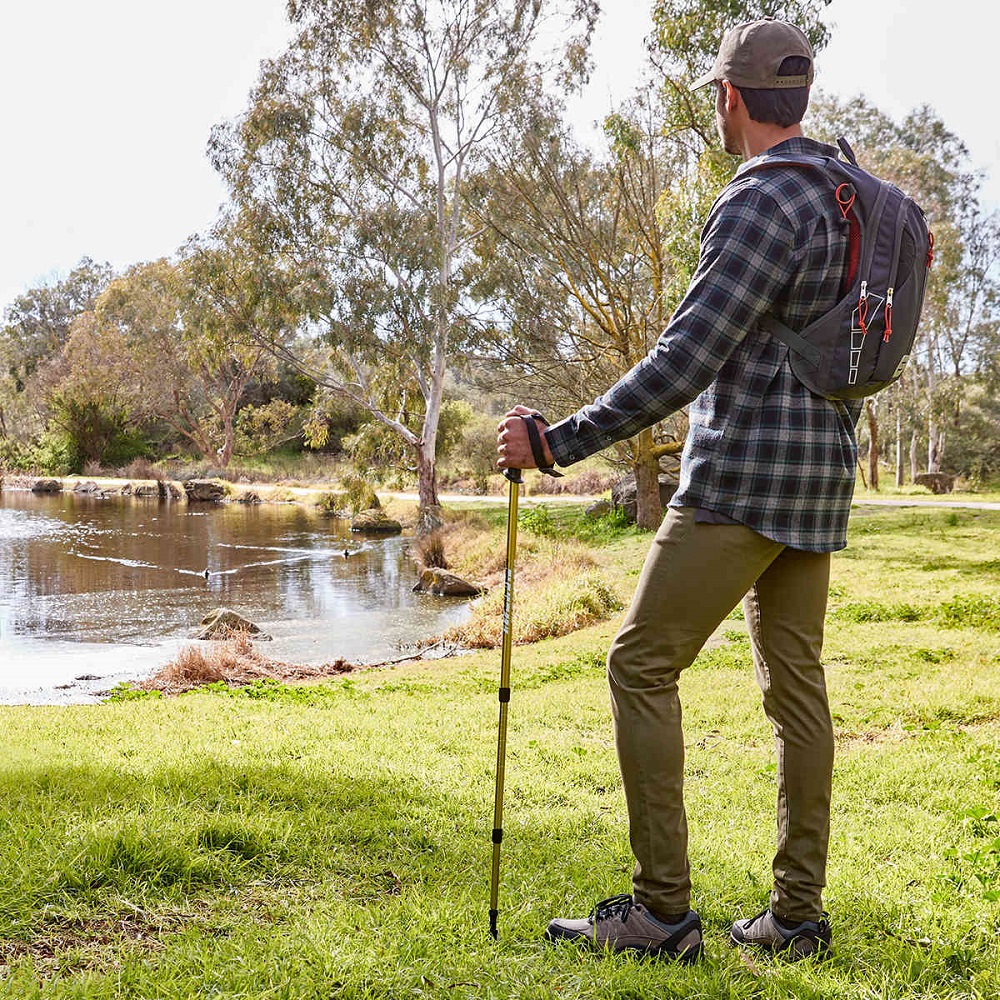
Features to Look for in Hiking Stick
When buying hiking sticks, specific features can greatly enhance your experience. These details improve usability, comfort, and durability. Here are key attributes to consider:
Shock Absorbers in Hiking Sticks
Shock absorbers reduce the impact on joints during hikes. They are ideal for challenging terrains:
- Benefit on Descents: Shock absorbers minimize strain on knees, especially downhill.
- Comfort on Long Treks: They help prevent fatigue by cushioning impacts.
- Types of Absorbers: Some sticks use internal springs, while others rely on more advanced technologies.
These features are especially useful for seniors or those with joint issues.
Locking Mechanisms for Adjustable Sticks
Locking mechanisms ensure the stability of adjustable hiking sticks. The main types include:
- Lever Locks: Quick and easy to adjust, ideal for cold or wet conditions.
- Twist Locks: Compact but may be harder to operate with gloves.
- Push-Button Locks: Reliable and simple, great for frequent length changes.
A secure locking system improves performance and prevents stick collapse during use.
Tips and Baskets for Different Surfaces
Tips and baskets adapt hiking sticks to various terrains. Essential options include:
- Carbide or Tungsten Tips: Offer grip on rocky or icy surfaces.
- Rubber Tips: Provide traction on paved or dirt trails.
- Snow Baskets: Prevent sinking in snow, useful for winter treks.
- Mud Baskets: Help maintain stability in muddy terrain.
Switching these attachments ensures better performance, no matter the surface or condition.
By focusing on these features, you can find hiking sticks that meet your specific needs and terrains.
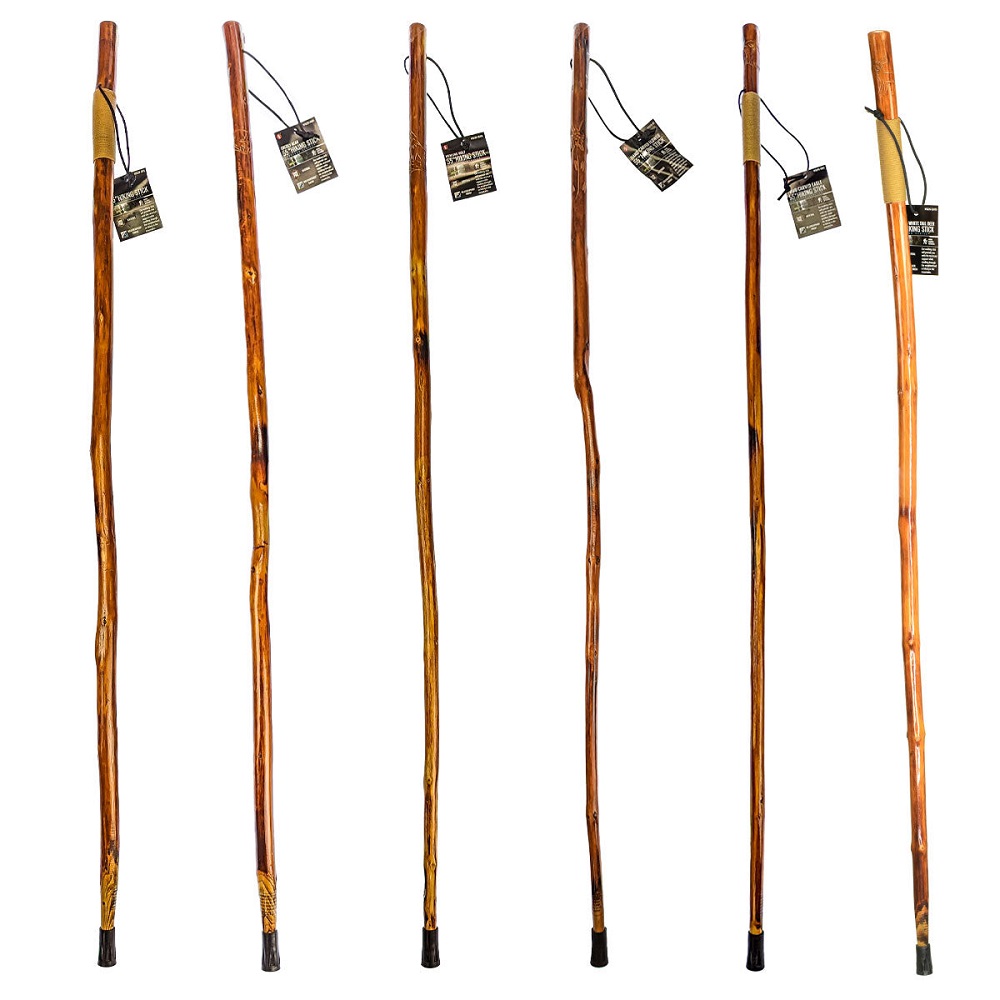
Size and Fit Guide for Hiking Stick
Choosing the right size and fit for hiking sticks is crucial for a comfortable hike. Properly sized sticks improve stability, reduce strain, and enhance overall hiking efficiency.
How to Measure for the Correct Stick Length
Measuring the correct length ensures optimal performance and comfort. Follow these quick steps:
- Stand Upright: Position yourself on a flat surface and stand naturally.
- Adjust to Your Height: The stick’s handle should reach your arm at a 90-degree angle.
- Consider Terrain: Longer lengths work better for flat trails, while shorter setup suits steep paths.
- Test Adjustability: For adjustable hiking sticks, modify the length based on surface gradients.
Matching the stick length to your height and terrain ensures maximum control during the hike.
Finding Your Optimal Grip Height
Proper grip height avoids discomfort and improves usability during your journey. Consider these factors:
- Natural Arm Position: When holding the stick, your elbow should be comfortably bent at a right angle.
- Extended Grips for Versatility: Extended grips allow easy changes in hand position without altering the stick length.
- Try Before Hiking: Grip the stick in different conditions to ensure its height feels right.
Adjusting the grip height ensures the hiking stick fits seamlessly into your natural walking motion.
By focusing on stick length and grip height, you’ll enhance comfort and stability for all terrains.
Maintenance and Care for Hiking Stick
Proper care for hiking sticks ensures they last longer and perform well. Regular cleaning prevents dirt buildup, while correct storage avoids unnecessary damage. Maintaining the parts also keeps them functional during hikes.
Cleaning and Storage Tips
Keeping hiking sticks clean and stored properly protects them from wear and tear. Follow these steps:
- Clean After Each Use: Remove dirt, mud, and debris with warm water and a soft cloth.
- Dry Thoroughly: Wipe them dry to prevent rust or water damage, especially on metal components.
- Inspect Regularly: Check for cracks, loose parts, or worn tips to avoid performance issues.
- Store in a Cool Place: Avoid extreme heat or moisture that can weaken materials.
- Collapse Before Storing: For adjustable sticks, collapse them fully to save space and prevent strain.
Proper cleaning and storage ensure your hiking sticks remain in excellent condition for future adventures.
How to Replace Tips and Straps
Replacing worn-out tips and straps is essential for safe and comfortable hiking. Here’s how:
- Removing Old Tips: Twist or pull gently to remove worn tips; use pliers if needed.
- Installing New Tips: Align the new tip and press firmly until it locks into place.
- Replacing Straps: Pull out damaged straps and slide the new strap through appropriate slots.
- Test Before Use: Ensure new tips and straps are secure to avoid accidents while hiking.
Regular replacement of parts improves performance and safety, especially on rugged terrains. Keep spare tips and straps handy for emergencies.
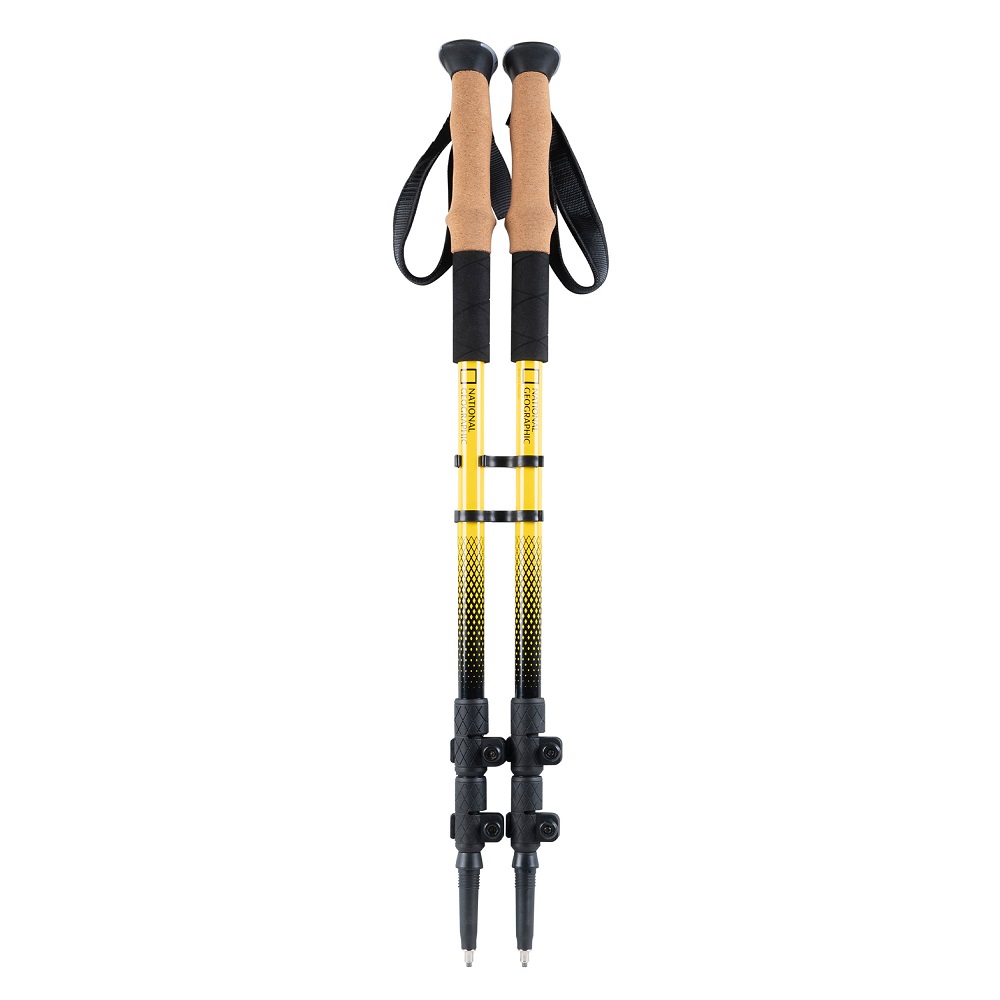
Top Brands and Recommendations for Hiking Stick
Selecting the right hiking stick brand can enhance your hiking experience. Brands differ in quality and features, catering to various needs and budgets.
Popular Hiking Stick Brands
Several brands are trusted for their durability, design, and performance. Here are some top recommendations:
- LEKI: Known for its innovative designs and reliable locking systems, perfect for regular hikers.
- Black Diamond: Offers premium quality sticks with shock absorbers and lightweight materials.
- TrailBuddy: Affordable options with adjustable lengths, great for beginners and budget-conscious hikers.
- Cascade Mountain Tech: Provides carbon fiber sticks that are ultralight and durable.
- Komperdell: Famous for ergonomic grips and high-end materials, ideal for long treks.
- Foxelli: Combines lightweight aluminum and comfort-focused designs at affordable prices.
These brands cater to varying terrains and user preferences. Test multiple brands to find your ideal pick.
Budget vs Premium Models
Hiking sticks come in a range of prices to suit different budgets. Here’s what to consider:
- Budget Models:
- Typically made of aluminum for strength and affordability.
- Less expensive but often heavier than premium models.
- Ideal for occasional hikers or beginners.
- Example: TrailBuddy Hiking Sticks.
- Premium Models:
- Use advanced materials like carbon fiber, making them lighter and stronger.
- Include advanced features like shock absorption and ergonomic grips.
- Best for experienced hikers or those tackling tough terrains.
- Example: Black Diamond Alpine Carbon Cork Poles.
Assess your needs and hiking frequency when choosing between budget and premium options. With proper care, even budget sticks can perform well.
Building a Hiking Routine
Committing to Regular Hiking
Once you have your hiking sticks, commit to regular outings. This establishes a routine and helps you gain confidence using your equipment. Setting specific goals, such as hiking a certain distance or exploring new trails, can enhance your motivation and enjoyment.
Embracing New Trails
Explore local parks or nature reserves to discover new trails. Each hike offers an opportunity to engage with nature and improve your hiking skills. Regularly challenging yourself helps build endurance and confidence, making each outing more rewarding.
Join a Hiking Group
Consider joining a local hiking group for added motivation. Hiking with others encourages camaraderie and shared experiences. An established group often has knowledge of various trails and can provide support in choosing routes that suit your ability level.
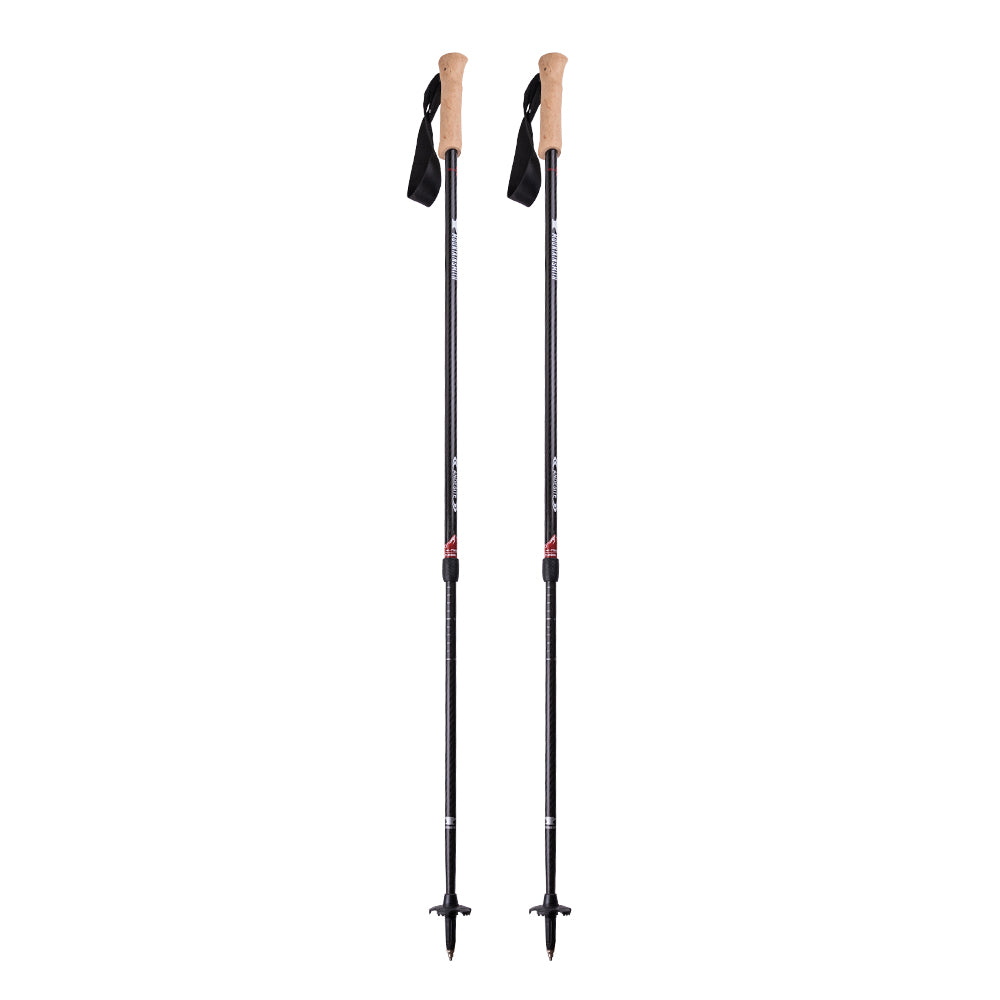
Embrace the Adventure
The Joy of Hiking
Hiking is a wonderful way to connect with nature and experience the great outdoors. With the right pair of diagonal pliers, you can enhance your journey and tackle various challenges along the way. Each hike offers an opportunity for adventure, relaxation, and personal growth.
Making the Most of Your Hiking Sticks
By selecting the right hiking sticks and practicing their use, you can maximize their benefits. Whether you are a beginner or an experienced hiker, the right equipment will help you enjoy your time on the trails. The connection between you and your hiking sticks will enrich your experience and make it even more memorable.
Encouragement for Future Hiking Adventures
As you embark on future hiking adventures, remember to embrace each moment. Stay adaptable and open to new experiences, knowing that every hike shapes your skills and confidence. With your modern hiking sticks, you’re ready to explore and enjoy the beauty of the outdoors. So grab your sticks, lace up your boots, and step into your next adventure!
